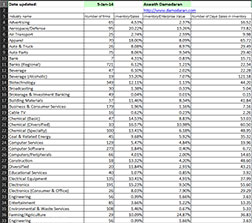Simple Retail Inventory Template
One of the primary pillars of any successful retail operation is inventory management. Retail inventory management techniques and tools like the retail inventory template helps stores and e-commerce sellers reduce costs, satisfy customers, and maximize profitability.
The Lowdown on Retail Inventory Management
Retail inventory management is the part of the supply chain where stock quantities and inventory are tracked as they move in and out of the warehouse. When retail inventory is managed accordingly, you can meet customer demands without carrying excess supply or running out of stocks.
Effective retail inventory management can also result in a better understanding of sales patterns and lower costs. Ultimately, a retail inventory template and other inventory tools can help ensure your inventory is automated and streamlined from picking to shipping.
Without retail inventory management, you risk not having enough supply of some items, an excess of others, mispicks, mis shipments, and many others. Out-of-stocks and overstocks can also occur when the inventory process is carried out manually.
The Importance of Retail Inventory Management
Retail inventory management is crucial as it increases efficiency and maximizes profit. However, it also provides other notable benefits that are hard to miss. For instance:
It lessens inventory costs
When you are aware of the stocks you have on hand, it is easier for you to decrease storage costs for any excess merchandise. Not only that, you can also save on logistics, depreciation, shipping, and opportunity costs. Tools like retail inventory templates can also lower inventory costs and increase profitability.
It lessens out-of-stocks
To avoid missing sales and minimize frustrated customers, you must avoid running out of inventory. A retail inventory template can come in handy as it can help you clearly see the stocks you have on hand.
With access to real-time information on the stocks available, you can react accordingly by reordering, drop shipping, or transferring stock from one location to another.
It helps improve multi-channel performance and order fulfillment
If you are selling via websites, third-party merchants, and physical stores, it can be challenging to be on top of inventory count across various channels at all times. This is especially true if you are still doing things manually. However, accurate inventory data across different channels is essential as it allows you to use inventory more efficiently so it gets to the consumers faster.
It helps reduce shrinkage
Shrinkage refers to the lost inventory due to product damage, fraud, vendor mistakes, shoplifting, administrative errors, and employee theft. According to some studies, the average supermarket loses as much as 3 percent of their sales through shrinkage.
Some data also suggest that most losses are attributed to incorrectly recording inventory on intake, misplacing items, or miscounting. Fortunately, a robust retail inventory system can reduce shrinkage by at much as half.
It facilitates growth and simplifies processes
Good inventory management ensures there is less friction in your processes as your business grows. Since order fulfillment and shipping runs smoothly, there are minimal errors, staff stress, and customer complaints.
It helps prevent obsolescence and spoilage
Retail inventory management can help address a costly issue when items become obsolete and expire. Typically, this applies to perishables that have limited shelf like meat or milk. Non-perishable items, on the other hand, can become obsolete since technology and consumer tastes can change drastically.
Examples of non-perishables that can become obsolete are holiday-specific packaging or season collections. Consumer technologies that add a new feature may also become highly popular while old models can face plummeting demands as a result.
It helps improve forecasting and customer satisfaction
Data you can see in your retail inventory template can help you project future growth, sales, and capital needs. Forecasting is crucial to your marketing and can help determine the budget required for product development, staffing, and marketing.
Retail inventory management is also beneficial if you want to increase customer satisfaction. Understandably, when customers get the right orders on time, it can increase their satisfaction and can help them become loyal consumers of the brand.
It helps ease supply chain management
A firm grip on sales and inventory trends can help you manage your supply chain more effectively. It also allows you to replenish systems that work for you best. Retain inventory management can also help you identify the economic order quantity or EOQ.
DOWNLOAD
